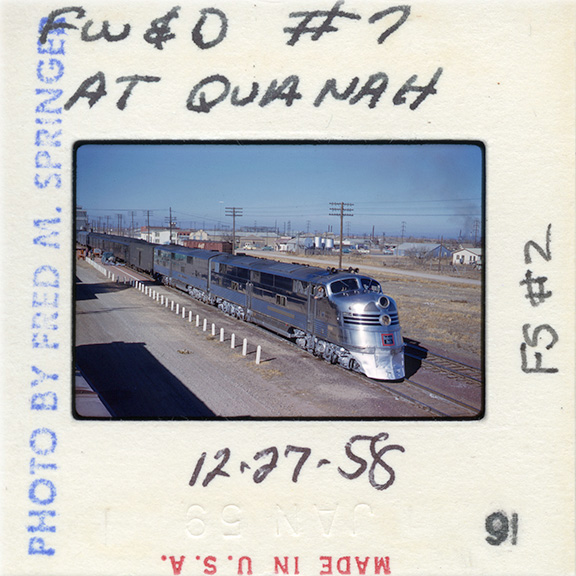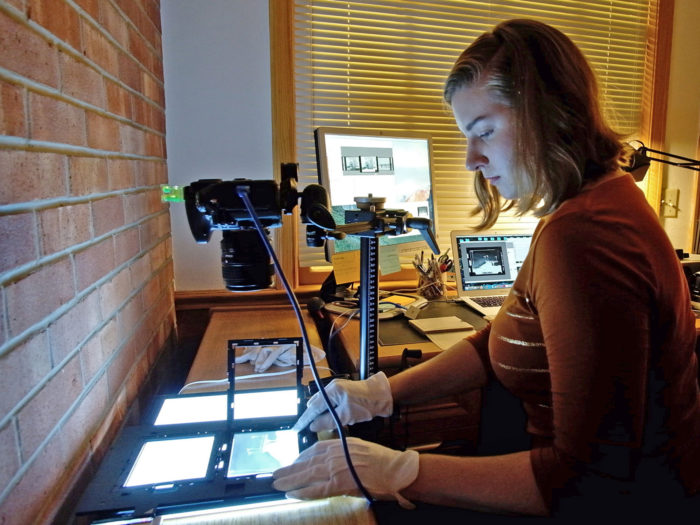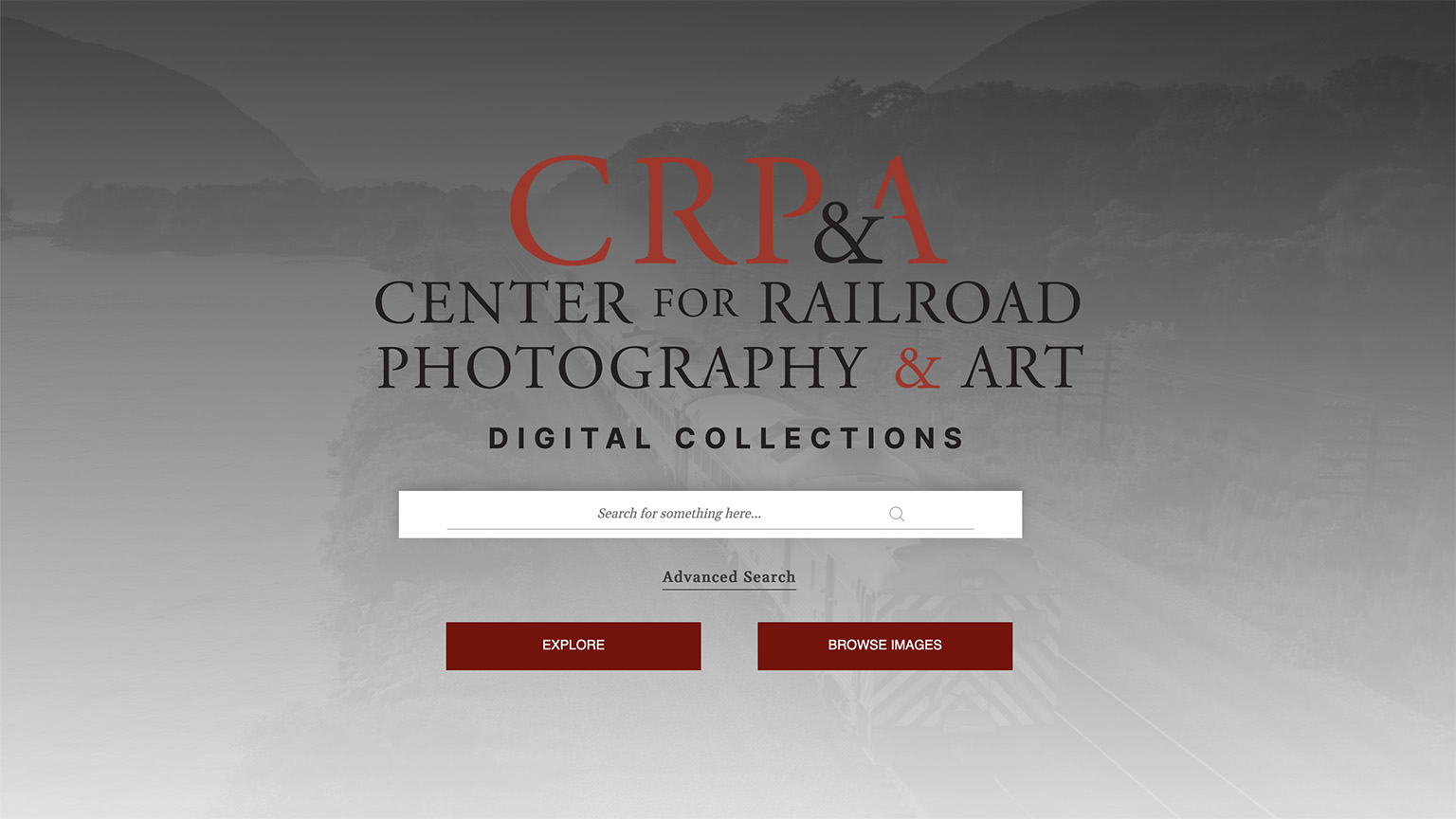Overview
THE CENTER CARES FOR more than 500,000 photographs in our Railroad Heritage Visual Archive under the leadership of Adrienne Evans, director of archives and collections. Our goal is to build a representative archive encompassing the many styles and subjects of railroad photography and art—from their beginnings in the early decades of the nineteenth century to the present, and from throughout the United States and the globe. Our mission is to preserve these images and make them accessible.
We’re able to do this work thanks to the generosity of our community.
- Multi-year support from the Elizabeth Morse Genius Charitable Trust has helped us build up every aspect of our collections work, from expanding our space, to adding more staff, to implementing our collections management system.
- Heritage grants from the National Railway Historical Society help fund our work on the John E. Gruber Collection and the Richard Steinheimer and Shirley Burman Steinheimer Collection.
- Thanks to the Railway & Locomotive Historical Society’s William D. Middleton Research Fellowship, we’ve been able to fill in more metadata for many of our collections.
- Our more than 1,000 members empower all of our programs through annual memberships and additional gifts. If you’re already a member, thank you. If you’re not, join now and begin receiving quarterly issues of our beautiful journal, Railroad Heritage.
Use the navigation tabs above or the links below to learn more about the different aspects of our archival work.
- Donations: All prospective submissions to our archive go through a review and approval process with our board of directors.
- Processing: Once a collection arrives at the Center, our team processes it to ensure its longevity and make it accessible.
- Usage: After processing, we make our collections available for research, publication, and other uses. Our staff members are available to assist with research requests for modest fees.
- Out of the Archives: Our outreach efforts include a regular column in our journal, Railroad Heritage, where we explore archiving topics, share highlights from our collections, and answer your questions.
You can read much more about our archival work by downloading our Collections Management Policy (206 KB PDF file), prepared by the Collections and Acquisitions Committee, adopted by the full board of directors, and reviewed and revised regularly.
Highlights include:
- Wallace W. Abbey Collection, approximately 23,000 black-and-white negatives and 8,000 color slides, acquired in 2010
- John F. Bjorklund Collection, 55,000 color slides, acquired in 2011
- Kenneth Burbach Collection, approximately 2,000 color slides, acquired in 2011
- Perry Frank Johnson Collection, approximately 5,000 black-and-white prints, acquired in 2009
- Donald W. Furler Collection, approximately 5,000 images, mostly black-and-white negatives, acquired in 2017
- Leo King Collection, approximately 14,000 images of various formats, acquired in 2006
- J. Parker Lamb Collection, approximately 2,700 black-and-white negatives in seven groups (as of March 2017, with more on the way), acquired in 2015
- Hal Lewis Collection, approximately 1,000 images of various formats, acquired in 2011
- Glenn Oestreich Collection, approximately 20 small boxes of prints and several thousand negatives, acquired in 2010
- David Plowden Collection, approximately 150 black-and-white railroad publicity prints and 30 archival prints for exhibition, acquired in 2012
- Ted Rose Collection, approximately 4,900 black-and-white negatives, acquired in 2006
- Fred M. Springer Collection, approximately 8,000 black-and-white negatives and 50,000 color slides, acquired in 2011
- Richard Steinheimer and Shirley Burman Steinheimer, more than 5,000 black-and-white prints, 2,700 negatives, and 30,000 slides, acquired in 2022
- Robert A. Witbeck Collection, approximately 1,100 black-and-white negatives, acquired in 2016
- Smaller collections from Lewis Ableidinger, Norm Adler, Chris Burger, Luther Gette, George R. Jones, Arno Lenz, Willis McCaleb, Bob Olmsted, Norbert Shacklette, Tom Sink, Doug Wornom, ranging from a dozen of photographs to several hundred.
Collection processing status
- Jim Shaughnessy:
In progress, Negatives: 95% complete; slides: TBD - John Gruber:
Negatives complete; slides to recommence later in 2025 - Ronald C. Hill:
Odyssey posting in progress - Henry Posner III:
Odyssey posting in progress - Richard Steinheimer / Shirley Burman Steinheimer:
In progress, ~40% complete - Stan Kistler:
In progress, ~20% complete - Karl Zimmermann:
Paused, ~20% of images onsite complete
Last updated: February 2025
Donating
Submissions
Because of the large number of railroad photographs in existence and because a great deal of specialized and costly work goes into processing photographs professionally, the Center carefully reviews all offers of photography donations before deciding which ones to accept. The two-step process begins with review by our five-member Collections and Acquisitions Committee. Their recommendations then go to our full Board of Directors for a final vote.
If you would like us to consider adding your collection to our archive, please get in touch with us by sending an email to info [at] railphoto-art [dot] org. Please describe your collection briefly, including, at a minimum:
- Size: the approximate total number of photographs and the amount of physical space they occupy
- Format(s): Slides, negatives, prints, etc.
- Range of years depicted, e.g., 1960s to 1990s
- Geographic regions depicted
- Railroads depicted
- Details about how your collection is currently housed
- Details about how your collection is currently organized and documented (please be accurate in your description)
- If available, send an example of your organization scheme and documentation
- If you note any preservation concerns such as water damage or vinegar syndrome, please let us know
- Submit a short bio (no more than one page) about yourself (or the collection’s creator)
- Send a selection of sample images (at least twenty-five)
Before submitting, we recommend that you download a copy of our Collections Management Policy (206 KB PDF file). It provides valuable, additional information. Our Collections and Acquisitions Committee reviews all offers very thoroughly. Because the committee meets only twice a year, you may not receive a decision from us for a few months. When we decide that we are not able to accept a collection, we make every effort to suggest other, often nearby institutions that photographers might pursue as a home for their work.
2024 Collecting Policy Update
In late 2024, the Center’s board of directors revised the Center’s collecting policy to accept collections at three different levels based on the number of images accepted into the archive. Acceptance levels are described below. Click each level for more information:
For more information regarding the revised policy, please see Out of the Archives columns no. 35 and no. 38 and our Dec. 2024 webinar, Behind the Scenes: CRP&A’s Collections Update


Kodachrome slides from the Center’s Fred M. Springer (above) and John F. Bjorklund collections.
Processing
A newly-acquired collection goes through several phases, collectively known as processing:
Phase 1: Arrangement and Description
- This is the initial planning phase for any collection where we get familiar with its materials.
- In this phase we will begin to organize the collection and create an inventory along with any information that can be used in a finding aid.
- Questions to address:
- What is in this collection?
- What is the original order of this collection?
- What are the main groupings of this collection?
- Keep in mind:
- Maintain original order if possible
- Understand a collection’s provenance
- Gain a general overview of a collection
- Recognize the condition and extent of a collection’s materials
Phase 2: Processing
- This phase involves long, tedious legwork but is essential in the general preservation and accessibility of the collection.
- Once the collection is organized we can apply labels to binders and pages while correctly matching up the physical materials with a digital inventory that will include metadata.
- Questions to address:
- Are materials in archival safe housing?
- Can this collection be digitized?
- Keep in mind:
- Use archival safe supplies such as plastic sleeves, polyethylene (PE) and polypropylene (PP), and heavy duty clamshell D-ring binders for photographic materials
- Perform any necessary cleanup such as removing rusty staples or paperclips and replace with archival safe fasteners
Phase 3: Metadata and Finding Aid
- Metadata, or data about data, are necessary to fully understand the materials in our collections. At the Center we record detailed metadata and embed that raw data into any digitized materials.
- Once we have finished processing a collection we can create a detailed and cohesive finding aid. This is the best way for our users to understand the scope and content of a collection.
- Questions to address:
- Are all available metadata recorded?
- Are there any unique metadata fields attributed to this collection?
- Is the finding aid available online and beneficial to users?
- Keep in mind:
- Metadata can include information such as creator, title, description, date, location, and railroad name
- Finding aids include collection summary, search terms, administrative information, biographical note, scope and content, and container list
Phase 4: Accessibility
- In the final phase, we strive to make our collections available to the public and searchable online via finding aids.
- Throughout the previous phases the Center will attempt to provide previews of collections online as they are processed.
- Questions to address:
- Can users find our collections online?
- Where can we make our collections accessible?
- Are the materials in our collections searchable?
- Keep in mind:
- The Center shares samples from its collections on its social media accounts with Facebook, Twitter, Flickr, Instagram, LinkedIn, and YouTube
- The Center’s usage terms are for educational use only, please contact the Center for other usage requests
- The Center’s copyright notice is: © YYYY, Center for Railroad Photography and Art, www.railphoto-art.org

Natalie Krecek, archives assistant, digitizes 4×5 negatives from our Victor Hand Collection.

Maddie Shovers, a former graduate intern from the University of Wisconsin’s School of Library and Information Studies, scanning negatives from our Leo King Collection.

Gilbert Taylor, contract archivist, reviews 8mm video footage in the Jim McClellan Collection.

Prints from the Perry Frank Johnson Collection after Center staff members and volunteers rehoused them into archival-safe pages and binders.
Image Usage and Research

Each issue of Classic Trains magazine features images from the Center’s collections in the “Archive Treasures” series, like this article in the Spring 2021 issue by Kevin P. Keefe about Ted Rose’s photography in Mexico.
Image Use
The Center for Railroad Photography & Art provides public access to our collections via our services, digital collections, and archives. Many of our materials are digitized and available for research and usage in various electronic formats. You can browse selected images from our collections on our website (go to the “Collections” menu button and then choose from the drop-down list) and Flickr account. Please use the contact information at right to send us your research inquiries and image requests. Please allow for up to two weeks of turnaround time to receive a response to your request.
To request digital copies of our images, first familiarize yourself with the Center’s unique image ID numbers (e.g., Lamb-01-001-01). Our staff members use these numbers to retrieve requested images. Please reference these ID numbers when making an image request. Non-profit, research, and other fair use requests are not subject to fees or licensing agreements. Commercial users will be asked to sign a licensing agreement and pay the appropriate fee. Please see fee schedule below.
We can supply images in JPEG, TIFF, or RAW file format. Digital copies of images can be sent via email, cloud-based file-sharing sites such as Dropbox, or by mailing a USB drive. Please note that transfers via USB drives are subject to reimbursement fees for the physical media and shipping (typically in the range of $10 to $20.)
We provide images free-of-charge for small press and self-published works, personal use, as well as educational and non-profit efforts. All other users, please see our Usage Fee Schedule for rates.
Research
In-person: Our collections are open to the public for research by appointment. To make an appointment, please use the contact information at right.
Distance: Research assistance is available by phone, email, and mail for patrons who are unable to visit the Center in person. This service is priced per hour of research time. The first hour of research is complimentary for all patrons. Examples include image retrieval and transfer by call number and basic collection inquiries. Center members receive a second hour of complimentary research. Additional research time will fall under the fee structure below. Staff will notify you if additional research time will be needed and advise you on the estimated cost. Payment will be due upon completion of the research. Payment for research services does not guarantee that the information/image will be found. As staff time is limited, please allow for up to two-week turnaround time for responses to research and image requests.
Research Assistant: If you require extensive research assistance beyond what the Center can provide, but cannot/do not wish to visit the Center, we suggest hiring a freelance researcher via University of Wisconsin’s History or Archival Studies departments.
CRP&A Research Fees:
| First hour of research | Complimentary |
| Second hour of research | Non-members: $25; Members: Complimentary |
| Additional hours (up to six) | Non-members: $35 per hour; Members: $25 per hour |
Credit line
In most cases the Center owns the copyright for the photographs in our collections. The Center does ask for the proper credit (see below) to recognize the photographer and the collection.
“Photograph by [PHOTOGRAPHER NAME], collection of the Center for Railroad Photography & Art, www.railphoto-art.org”

Show-Me Katy by Michael A. Landis features a photograph from our John F. Bjorklund Collection on the cover and dozens more inside.
Address and hours
Center for Railroad Photography & Art
1930 Monroe Street, Suite 301
Madison, Wisconsin 53711
608-251-5785 ext. 104
info[at]railphoto-art[dot]org
We typically keep normal business hours of 9:00 a.m. to 5:oo p.m., Monday through Friday. Please check ahead of time to ensure that someone from our collections staff will be available to meet with you.
Out of the Archives

The Center expanded into a new archival storage facility in October 2019, offering more space and better environmental controls for our collections. Photograph by Scott Lothes
OUR ARCHIVAL OUTREACH EFFORTS include “Out of the Archives,” a regular column in Railroad Heritage that brings to light the world of professional archiving, providing a regular forum to share selections from our collections and tips for maintaining your own photographs. Whether you are a photographer, collector, or avid fan, it is important to organize and preserve the materials you create or collect. In this digital version of the column, we will be delivering every installment to further promote the significance and standards of the archiving world. Please let us know if there are any topics you would like us to cover in the future.
Members and supporters of the Center receive a new issue of Railroad Heritage each quarter. We post PDF files of “Out of the Archives” on this page a few weeks following publication of each issue. See the list at right and click on the link to view or download the file.
Archival Principles
Here at the Center we adhere to established archival principles to ensure safety and accuracy. Our work as archivists includes:
- Preservation. One of the Center’s main objectives is properly preserving our collections. This includes appropriately caring for and handling our materials by using archival-safe supplies, and providing a controlled environment where our collections are housed.
- Processing. Processing materials is a long, tedious, and detailed endeavor. Organizing a collection appropriately sets up the rest of the processing work that includes any digitization and metadata entry. This work is essential to the long-term care and future accessibility of a collection.
- Arrangement and Description. To maintain quick and easy retrieval of our materials, we organize every collection down to its individual items, if possible, given the time and resources available to us.
- Accessibility. Finally, the Center will make sure that users have access to our processed collections. We create detailed finding aids to describe each collection and its contents and share images electronically through our websites and many social media outlets.
Additional Resources
- CRP&A Preservation Resources List
- Society of American Archivists (SAA): www2.archivists.org
- Print File Archival Supplies: www.printfile.com
- Gaylord Archival Supplies: www.gaylord.com
- Facebook: www.facebook.com/railphotoart
- Twitter: twitter.com/railphotoart
- Flickr: www.flickr.com/photos/railphotoart
Out of the Archives
- Introduction, Organization, and Metadata
- Scanning and Digital Files
- Processing and Submissions
- Redesigned Website
- Metadata
- Intellectual Property
- Gallery of Recent Acquisitions
- Why Scan What You Can Shoot?
- Copyright Follow-up Questions and Answers
- An Introduction to Born-Digital Materials
- Understanding and Using Finding Aids
- Metadata revisited: Best practices and prioritizing
- A brief guide to donating to archives
- Collaborating with many archives on After Promontory
- New trends, connections, and experiences at MAC 2019
- Gallery from recent acquisitions and processing
- New archives space
- Building up our capacity
- Glass plate negatives: part 1
- Glass plate negatives: part 2
- New research and usage policies
- An introduction to cyanotypes
- How to house your photographs like an archivist
- Updates and gallery: fall color edition
- Evolving digitization criteria
- What we do in the shadows
- The Force is strong with this one
- Steinheimer week in Sacramento
- Every month is archives month
- An interview with Adrienne Evans
- A moving-image film primer
- Odyssey tips and tricks
- Print Acquisition Program
- Henry Posner III gallery
- A pause to manage growth
- And into the underground
- Image requests
- Policy revisions

